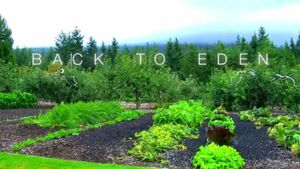Back to Eden
Back to Eden is a no-till organic gardening method developed by Paul Gautschi, as well as a 2011 full-length documentary on the gardening style. It uses a thick layer of wood chips as mulch to cover and protect the soil and conserve water.
The Back to Eden method also relies on composting garden waste to return the nutrients to the soil by adding the compost on top of the current layer of mulch. Gautschi feeds his garden waste to his chickens who eat anything palatable and constantly turn the remains, along with their defecation, which ages in the chicken run to make a high-quality compost which is screened before returned to the garden.
Initially, Gautschi notes, there may be a need to add a high-quality organic fertilizer like horse or chicken manure compost to poor quality soil replace some of the minerals that may have been lost. However, with a thick wood chip mulch, this input will be required less and less over time and eventually would not need to be added.
Gautschi waters supplementary after planting, but relies on rain and the mulch's ability to protect the rainwater from evaporation as his watering method.
Establishment
To establish a Back to Eden style garden:
- Clear the site of thistle, dandelion, grapevine, and other opportunistic plants.
- Place 3-4 layers of newspaper sheets on the ground with a thin layer of compost on top to hold the newspaper in place.
- Add 2-3 inches of compost on top of the newspaper, followed by 3-4 inches of aged wood chips, and 1/2 inch of manure.
- Part the layers to reach the compost and plant the seeds in contact with the compost. Do not plant the seeds directly in the wood chips.
- Side dress with wood chips after the seeds have sprouted and are taller than the wood chips.
Raised garden bed
Back to Eden gardening is possible in a raised garden bed but the method is slightly modified.[1]
- Build the raised beds with at least 12 inches of depth.
- If wood is being used, ensure it is untreated.
- Leave the bottom of the bed open.
- Clear any opportunistic plants from inside the raised bed.
- Fix gopher wire to the base of the raised beds.
- Fill the bed with compost, leaving 4-5 inches.
- Continue the base directions starting at adding wood chips and manure.
- If the compost height significantly lowers after one year, the layer of wood chips can be moved to one side of the bed, more compost added, and the layer of wood chips can be returned.
- The wood chips should never been incorporated into the compost.
